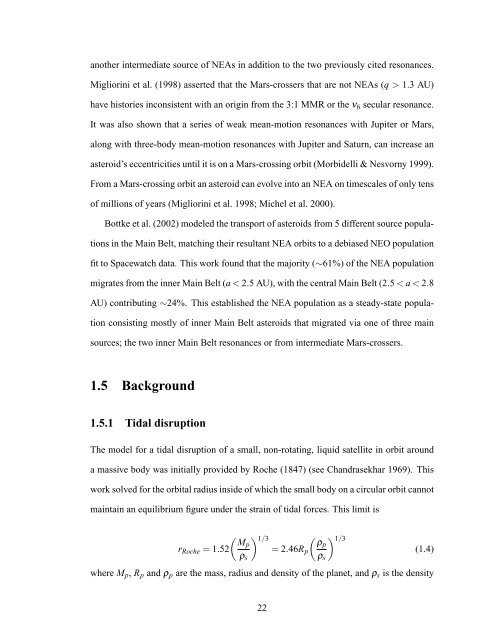Forming Binary Near-Earth Asteroids From Tidal Disruptions
Forming Binary Near-Earth Asteroids From Tidal Disruptions
Forming Binary Near-Earth Asteroids From Tidal Disruptions
Create successful ePaper yourself
Turn your PDF publications into a flip-book with our unique Google optimized e-Paper software.
another intermediate source of NEAs in addition to the two previously cited resonances.Migliorini et al. (1998) asserted that the Mars-crossers that are not NEAs (q > 1.3 AU)have histories inconsistent with an origin from the 3:1 MMR or the ν 6 secular resonance.It was also shown that a series of weak mean-motion resonances with Jupiter or Mars,along with three-body mean-motion resonances with Jupiter and Saturn, can increase anasteroid’s eccentricities until it is on a Mars-crossing orbit (Morbidelli & Nesvorny 1999).<strong>From</strong> a Mars-crossing orbit an asteroid can evolve into an NEA on timescales of only tensof millions of years (Migliorini et al. 1998; Michel et al. 2000).Bottke et al. (2002) modeled the transport of asteroids from 5 different source populationsin the Main Belt, matching their resultant NEA orbits to a debiased NEO populationfit to Spacewatch data. This work found that the majority (∼61%) of the NEA populationmigrates from the inner Main Belt (a < 2.5 AU), with the central Main Belt (2.5 < a < 2.8AU) contributing ∼24%. This established the NEA population as a steady-state populationconsisting mostly of inner Main Belt asteroids that migrated via one of three mainsources; the two inner Main Belt resonances or from intermediate Mars-crossers.1.5 Background1.5.1 <strong>Tidal</strong> disruptionThe model for a tidal disruption of a small, non-rotating, liquid satellite in orbit arounda massive body was initially provided by Roche (1847) (see Chandrasekhar 1969). Thiswork solved for the orbital radius inside of which the small body on a circular orbit cannotmaintain an equilibrium figure under the strain of tidal forces. This limit is( ) 1/3 ( ) 1/3 Mpρpr Roche = 1.52 = 2.46R p (1.4)ρ s ρ swhere M p , R p and ρ p are the mass, radius and density of the planet, and ρ s is the density22












